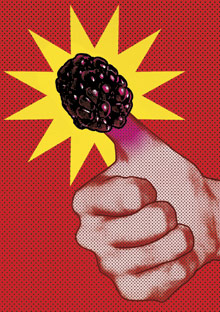Cures for Your Wireless Wounds

Photo Illustration: Sean McCabe
We used to push paper; now we push buttons—and the result is getting ever more painful. From BlackBerries and Treos to cell phones and iPods, our miniaturized, high-tech gizmos are leaving us with a whole new set of repetitive stress injuries that go beyond carpal tunnel syndrome (which caused those afflicted to typically miss 27 days from work in 2005, according to the U.S. Bureau of Labor Statistics). Here;s what you should know about the next generation of gadgetry woes:
BlackBerry Thumb
This condition can develop from constant e-mailing, text messaging, or Internet surfing on handheld devices. "Thumbs are not very dexterous, and subjecting them to continual pressure can lead to irritation," says Michele Kehrer, a physical therapist and owner of the LifeStyle Physical Therapy & Balance Center in Chicago.
Symptoms: Pain or numbness in the thumbs and thumb side of the wrist.
Solution: Use a stylus or pen to punch the keys on your PDA. Stretch out thumbs periodically. Ice them if they are sore.
Cell Phone Elbow
No kidding. Cubital tunnel syndrome can result from constantly holding a cell phone to the ear. In severe cases, it can cause permanent nerve damage, and surgery may be the only option, says Kehrer.
Symptoms: Elbow pain; numbness, pain, or tingling in the little fingers.
Solution: Invest in a headset. Or switch the cell phone from your right to left hand periodically.
PDA Hunch
Looking straight down at your mini monitor flexes the neck in an unnatural position, says Manhattan chiropractor Marc Bochner.
Symptom: Neck pain.
Solution: Set an alarm and take breaks approximately five minutes every half hour. Get up, stretch, and walk around.
Mouse Arm
"Most people using a mouse keep their hand and forearm tense even when they;re not clicking," says physical therapist Rik Misiura, owner of Central Park Physical Therapy in New York City. "So in addition to straining the finger, over time you can also develop tendinitis in the elbow, where the muscle operating the finger originates."
Symptom: Pain on the outside of the elbow, usually when grasping or lifting.
Solution: Keep the mouse close to you so that you're not reaching for it. And for relief, Misiura suggests this exercise: Imagine you have water on your hands, and vigorously shake it off for seven seconds. Next bring your hands behind your head and neck from above and swing them down in front of you, forward, then backward; repeat for seven repetitions.
BlackBerry Thumb
This condition can develop from constant e-mailing, text messaging, or Internet surfing on handheld devices. "Thumbs are not very dexterous, and subjecting them to continual pressure can lead to irritation," says Michele Kehrer, a physical therapist and owner of the LifeStyle Physical Therapy & Balance Center in Chicago.
Symptoms: Pain or numbness in the thumbs and thumb side of the wrist.
Solution: Use a stylus or pen to punch the keys on your PDA. Stretch out thumbs periodically. Ice them if they are sore.
Cell Phone Elbow
No kidding. Cubital tunnel syndrome can result from constantly holding a cell phone to the ear. In severe cases, it can cause permanent nerve damage, and surgery may be the only option, says Kehrer.
Symptoms: Elbow pain; numbness, pain, or tingling in the little fingers.
Solution: Invest in a headset. Or switch the cell phone from your right to left hand periodically.
PDA Hunch
Looking straight down at your mini monitor flexes the neck in an unnatural position, says Manhattan chiropractor Marc Bochner.
Symptom: Neck pain.
Solution: Set an alarm and take breaks approximately five minutes every half hour. Get up, stretch, and walk around.
Mouse Arm
"Most people using a mouse keep their hand and forearm tense even when they;re not clicking," says physical therapist Rik Misiura, owner of Central Park Physical Therapy in New York City. "So in addition to straining the finger, over time you can also develop tendinitis in the elbow, where the muscle operating the finger originates."
Symptom: Pain on the outside of the elbow, usually when grasping or lifting.
Solution: Keep the mouse close to you so that you're not reaching for it. And for relief, Misiura suggests this exercise: Imagine you have water on your hands, and vigorously shake it off for seven seconds. Next bring your hands behind your head and neck from above and swing them down in front of you, forward, then backward; repeat for seven repetitions.
As a reminder, always consult your doctor for medical advice and treatment before starting any program.



